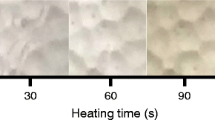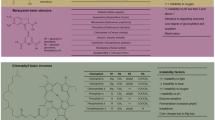Abstract
In the present study, a new microbial TTI system was developed based on encapsulation techniques. TTI response (color change) was evaluated by using primarily the CIELab coordinates which were further used for the conversion into the secondary and tertiary variables and finally compared all the variables to choose the best ones for calculation of activation energy (Ea) quickly and accurately. In order to select the best variables for calculating the Ea, 95% confidence interval was also used. Primary variable a* exhibited the best linearity, narrowest 95% confidence interval and simplicity in interpretation of the color-developing reaction. Ea of the developed microbial TTIs ranged from 57.28 to 110.23 kJ/mol and maintains a consistent performance similar to that of other microbial and nonmicrobial TTIs which are commercially available. Therefore, it can be concluded that this new microbial TTI system can be used effectively in the food industry for monitoring food quality.
Similar content being viewed by others
References
Vaikousi H, Biliaderis CG, Koutsoumanis KP. Development of a microbial time temperature indicator (TTI) prototype for monitoring microbiological quality of chilled foods. Appl. Environ. Microbiol. 74: 3242–3250 (2008)
Nuin M, Alfaro B, Cruz Z, Argarate N, George S, Marc YL. Modelling spoilage of fresh turbot and evaluation of a timetemperature integrator (TTI) label under fluctuating temperature. Int. J. Food Microbiol. 127: 193–199 (2008)
Tsironi T, Stamatiou A, Giannoglou M, Velliou E, Taoukis PS. Predictive modelling and selection of time temperature integrators for monitoring the shelf life of modified atmosphere packed gilthead seabream fillets. LWT-Food Sci. Technol. 44: 1156–1163 (2011)
Mendoza TF, Welt BA, Otwell S, Teixeira AA, Kristonsson H, Balaban MO. Kinetic parameter estimation of time-temperature integrators intended for use with packaged fresh seafood. J. Food Sci. 69: 90–96 (2004)
Taoukis PS. Application of time-temperature integrators for monitoring and management of perishable product quality in the cold chain. pp. 61–73. In: Smart Packaging Technologies for Fast Moving Consumer Goods. Kerry J, Buttler B (eds). John Wiley & Sons Ltd., Chichester, West Sussex, UK (2008)
Kim KH, Kim EJ, Lee SJ. 2012. New enzymatic time-temperature integrator (TTI) that uses laccase. J. Food Eng. 113: 118–123 (2012)
Ellouze M, Augustin JC. Applicability of biological time temperature integrators as quality and safety indicators for meat products. Int. J. Food Microbiol. 138: 119–129 (2010)
Taoukis PS, Labuza TP. Applicability of time temperature indicators as shelf life monitors of food products. J. Food Sci. 54: 783–788 (1989a)
Pacquit A, Crowley K, Diamond D. Smart packaging technologies for fish and seafood products. pp. 75–98. In: Smart Packaging Technologies for Fast Moving Consumer Goods. Kerry J, Buttler B (eds). John Wiley & Sons Ltd., Chichester, West Sussex, UK (2008)
Taoukis PS, Koutsoumanis K, Nychas GJE. Use of timetemperature integrators and predictive modeling for shelf life control of chilled fish under dynamic storage conditions. Int. J. Food Microbiol. 53: 21–31 (1999)
Kim MJ, Jung SW, Park HR, Lee SJ. Selection of an optimum pHindicator for developing lactic acid bacteria-based time-temperature integrators (TTI). J. Food Eng. 113: 471–478 (2012)
Vaikousi H, Biliaderis CG, Koutsoumanis KP. Applicability of a microbial time temperature indicator (TTI) for monitoring spoilage of modified atmosphere packed minced meat. Int. J. Food Microbiol. 133: 272–278 (2009)
Shah NP, Ravula RR. Microencapsulation of probiotic bacteria and their survival in frozen fermented dairy desserts. Austral. J. Dairy Technol. 55: 139–144 (2000)
Sheu TY, Marshall RT. Microentrapment of Lactobacilli in calcium alginate gels. J. Food Sci. 54: 557–561 (1993)
Akamatsu K, Maruyama K, Chen W, Nakao A, Nakao SI. Drastic difference in porous structure of calcium alginate microsphers prepared with fresh or hydrolyzed sodium alginate. J. Colloid. Interf. Sci. 363: 707–710 (2011)
Mokarram RR, Mortazavi SA, Habibi Najafi MB, Shahidi F. The influence of multi stage alginate coating on survivability of potential probiotic bacteria in simulated gastric and intestinal juice. Food Res. Int. 42: 1040–1045 (2009)
Korea Food and Drug Administration. The guide line for establishment of shelf life of foods. Available from: http://kfda.go.kr. Accessed Oct. 15, 2012.
Wanihsuksombat C, Hongtrakul V, Suppakul P. Development and characterization of a prototype of a lactic acid-based timetemperature indicator for monitoring food product quality. J. Food Eng. 100: 427–434 (2010)
Sakkalis T. The topological conguration of a real algebraic curve. Bull. Austrl. Math. Soc. 43: 37–50 (1991)
Fu B, Labuza TP. Shelf-life testing: procedures and prediction methods for frozen foods. pp. 377–415. In: Quality in Frozen Food. Erickson MC, Hung YC (eds). Chapman & Hall, New York, NY, USA (1997)
Welt BA, Sage DS, Berger KL. Performance specification of timetemperature integrators designed to protect against botulism in refrigerated fresh foods. J. Food Sci. 68: 1–8, (2003)
Taoukis PS, Labuza TP. Reliability of time-temperature indicators as food quality monitors under nonisothermal conditions. J. Food Sci. 54: 789–792 (1989b)
Fu B, Taoukis PS, Labuza TP. Predictive microbiology for monitoring spoilage of dairy products with time-temperature indicators. J. Food Sci. 56: 1209–1215 (1991)
Taoukis PS. Modelling the use of time-temperature indicators in distribution and stock rotation. pp. 402–431. In: Food Process Modelling. Tijskens LMM, Hertog MLATM, Nicolai BM (eds). CRC Press, Washington, DC, USA (2001)
Giannakourou MC, Taoukis PS. Application of a TTI-based distribution management system for quality optimization of frozen vegetables at the consumer end. J. Food Sci. 68: 201–209 (2003)
Giannakouroua M, Koutsoumanisb K, Nychasc GJE, Taoukis PS. Field evaluation of the application of time temperature integrators for monitoring fish quality in the chill chain. Int. J. Food Microbiol. 102: 323–36 (2005)
Tsironi T, Gogou E, Velliou E, Taoukis PS. Application and validation of the TTI based chill chain management system SMAS (safety monitoring and assurance system) on shelf life optimization of vacuum packed chilled tuna. Int. J. Food Microbiol. 128: 108–115 (2008)
Shimoni E, Anderson EM, Labuza TP. Reliability of timetemperature indicators under temperature abuse. J. Food Sci. 66: 1337–1340 (2001)
Yan S, Huawei C, Limin Z, Fazheng R, Luda Z, Hengtao Z. Development and characterization of a new amylase type timetemperature indicator. Food Control 19: 315–319 (2008)
Author information
Authors and Affiliations
Corresponding author
Rights and permissions
About this article
Cite this article
Mijanur Rahman, A.T.M., Jung, S.W., Choi, D.Y. et al. Investigation of the temperature dependence of encapsulated microbial cells based TTI by applying a variety of color parameters. Food Sci Biotechnol 22, 1–9 (2013). https://doi.org/10.1007/s10068-013-0219-1
Received:
Revised:
Accepted:
Published:
Issue Date:
DOI: https://doi.org/10.1007/s10068-013-0219-1




